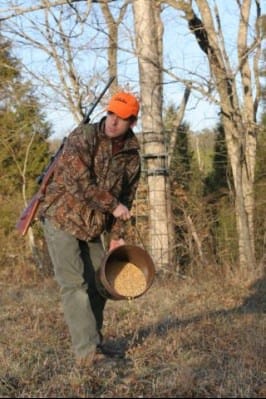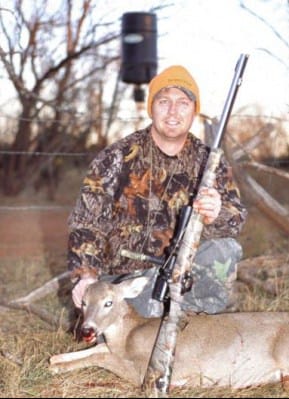
Few issues among hunters are contentious as bait. Whether you love, hate it, or fall somewhere in between, baiting for deer, bear or other game is legal in at least 35 states. Pennsylvania recently legalized bait for deer in five southeastern counties as a means to help reduce burgeoning deer numbers. Connecticut also allowed it in selected zones in 2005 to help increase hunter success rates. Baiting is a way of life among Texas deer hunters and the whirring sound of an automatic feeder is as common as the clicking of a pair of rattling antlers.
Does it actually help? Depends. Bait does tend to draw high numbers of antlerless deer and small bucks, creating a higher chance of success for young and handicapped hunters. In some places, however, baiting is so prevalent, it has actually led to lower success rates. In South Carolina’s Coastal Plain, where baiting has never been illegal, researchers have determined that a deer has to walk an average of only 425 yards to find a pile of corn. As a result, bait has turned into supplemental food, a steady supply of nutritious food available 24 hours a day. Deer in that region don’t move much, at least not during daylight hours, because they don’t have to. Biologists actually charted deer movement and found that it is extremely low during legal shooting hours, but spikes right after dark and right before daylight.
In Saskatchewan, however, extreme cold and constant snow cover forces deer to feed more often, seeking out the easiest food that offers the most nutrition. A pile of corn or barley fits that bill perfectly, and Canada whitetails do visit bait throughout the day. Of course, restricted hunting pressure also helps deer stay active during daylight hours, but the bait, according to Gerald Melnychuk, an outfitter from Saskatchewan, is the primary reason success rates are so high.
“I also think it’s one reason we have not only good numbers of deer in our area, but a high number of big bucks,” he said. “Bait helps carry our deer through hard winters because they go into winter in better shape than deer that don’t have access to bait.”
The real issue with bait isn’t whether or not it works. For many hunters, the question of baiting comes down to this: Is it right to shoot a deer with it’s nose in a pile of corn or an artificial mineral lick placed 50 yards from a tree stand? Or is bait the same as hunting over a well-manicured food plot grown specifically for attracting whitetails or other game? Ask a dozen hunters and you’ll surely get a dozen answers.
However, where it is legal, deer corn flies off the feed store shelves as fast as it gets stocked in places like Texas and Michigan. One hunt club in South Carolina was feeding at a rate of 1,000 pounds per square mile, according to a report released by the South Carolina Department of Natural Resources.

Some of that corn can be deadly to deer and other wildlife, even if no one is hunting over it. Studies in Texas and South Carolina found that as much as half of all corn sold for deer is tainted with aflatoxin, a naturally-occurring fungus that can be fatal to wildlife. Other studies have determined that deer overbrowse natural forage in areas around feeders, and predation of ground-nesting birds like turkeys, quail and songbirds is considerably higher around baited areas. Also, biologists are concerned that bait artificially concentrates deer in small areas, making the spread of disease like bovine tuberculosis and chronic wasting disease a greater risk.
Then there is the social issue. Not only does baiting turn hunter against hunter, it creates a negative image of all hunters by the non-hunting public. Numerous surveys have found public opinion squarely against the practice. It’s perceived as unfair and unethical. Does that matter? Or should hunters be allowed to decide what’s right without worrying about what others think?



